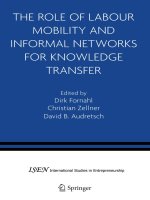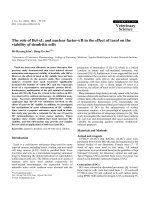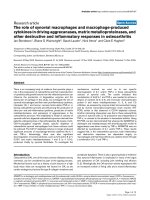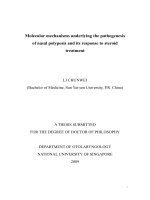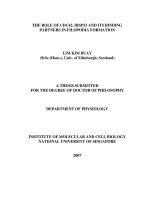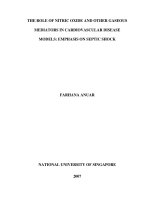The role of CDC42, 1RSP53 and its binding partners in filopodia formation
Bạn đang xem bản rút gọn của tài liệu. Xem và tải ngay bản đầy đủ của tài liệu tại đây (11.78 MB, 341 trang )
THE ROLE OF CDC42, IRSP53 AND ITS BINDING
PARTNERS IN FILOPODIA FORMATION
LIM KIM BUAY
(B.Sc.(Hons.), Univ. of Edinburgh, Scotland)
A THESIS SUBMITTED
FOR THE DEGREE OF DOCTOR OF PHILOSOPHY
DEPARTMENT OF PHYSIOLOGY
INSITITUTE OF MOLECULAR AND CELL BIOLOGY
NATIONAL UNIVERSITY OF SINGAPORE
2007
Acknowledgement
I wish to extend my gratitude to Prof. Sohail Ahmed for giving me the opportunity to
study in his lab and for all support and patience throughout the duration of my studies.
For his guidance, encouragement and enthusiasm during my studentship. Thank you
to Dr. Sudhaharan Thankiah for his help and advice in the FRET experiments. I am
also indebted to Helen Pu and Dr. Esther Koh for their advice and stimulating
discussion sessions. I would like to extend my sincerest thanks to members of my
committee, Dr. Ed Manser and Dr. Uttam Surana for their support and guidance.
I would like to acknowledge members of the lab who have offered me
invaluable practical instructions. A special mention to Sem Kai Ping, Bu Wenyu and
Dr. Yu Feng Gang. With lots of appreciation towards Wah Ing, for proof reading the
thesis twice. I also thank all my colleagues past and present, for providing an
enjoyable working environment and motivating me especially during the period I
have spent writing my thesis.
Finally, many thanks to my family and all my friends, who have continually
been a source of inspiration and offered their genuine support and encouragement, for
which, I am sincerely grateful.
ii
Table of Contents
Acknowledgements ii
Contents iii
Summary xi
List of Tables xii
List of Figures xiii
List of Abbreviations xvi
Chapter 1 Introduction
1.1 The cell as a fundamental unit of life 1
1.1.1 Cell migration 2
1.1.2 Lamellipodia and membrane ruffling 2
1.1.3 Filopodia 4
1.2 The Cytoskeleton 7
1.2.1 Components of the cytoskeleton 7
1.2.2 Actin microfilaments 8
1.2.3 Mircotubules 9
1.2.4 Intermediate filaments 10
1.3 Microfilaments assembly and disassembly: Actin dynamics 11
1.3.1 Arp 2/3 complex 12
1.3.2 Myosin 13
1.3.3 Actin binding proteins 14
1.4 The Ras Superfamily 18
1.4.1 Ras superfamily members 19
1.4.2 Ras as a molecular switch 21
1.4.3 Mutations and oncogenic Ras 23
1.4.4 Ras GTPase regulatory proteins 25
1.4.4.1 Ras guanine nucleotide exchange factors (RasGEFs) 25
1.4.4.2 Ras GTPase activating proteins (RasGAPs) 26
1.4.5 Ras effectors 28
iii
1.5 Rho Family 29
1.5.1 Regulators of Rho GTPases 30
1.5.2 Rho GEFs 30
1.5.3 Rho GAPs 33
1.5.4 Rho GDIs 35
1.6 Rho Family Functions 37
1.6.1 Cdc42 37
1.6.2 Rac1 39
1.6.3 Rho 40
1.7 Rho Family Effector Proteins 41
1.7.1 The CRIB motif 41
1.7.2 PAK family kinases 41
1.7.3 MRCK 43
1.7.4 ACK 45
1.7.5 ROK 45
1.7.6 PKN 46
1.7.7 Rho GTPase effectors – adaptor proteins 46
1.8 The WASP and VASP family of actin polymerization regulators 47
1.8.1 WASP family domain structure 48
1.8.2 WASP 51
1.8.3 N-WASP 52
1.8.4 WAVE family proteins 55
1.8.5 Ena/VASP family of proteins 56
1.8.6 Ena/VASP and Mena 56
1.8.7 EVL 60
1.8.8 Abi proteins 62
1.9 IRSp53 63
1.9.1 Introduction 63
1.9.2 Domain families and structure 64
1.9.3 IRSp53 function 64
iv
1.10 Functional roles of filopodia 67
1.10.1 Components of filopodia 67
1.10.2 Rho family signalling, lamellipodia and filopodia 68
1.10.3 Axonal guidance 69
1.10.4 Metastasis 70
1.10.5 Cell motility and immunity 73
1.10.6 Wound healing 75
1.10.7 Aims of thesis 77
Chapter 2 Materials and methods
2.1 Materials 78
2.1.1 General laboratory reagents 78
2.1.2 DNA manipulation reagents 78
2.1.3 Protein manipulation reagents 78
2.1.4 Tissue culture reagents 79
2.1.5 Reagents for immunodetection and immunofluorescence 79
2.1.5.1 Phalloidin 79
2.1.5.2 Primary antibodies 80
2.1.5.3 Secondary antibodies 80
2.1.6 cDNA constructs 80
2.1.7 Oligomers synthesis and DNA sequencing service 81
2.2 Methods 81
2.2.1 Plasmid DNA preparation 81
2.2.1.1 Transformation of E.coli (XL1-Blue competent cells) 81
2.2.1.2 Qiagen Mini preps 81
2.2.1.3 Qiagen Maxi preps 82
2.2.1.4 Quantification of DNA in solution 84
2.2.1.5 Qiagen “Magic DNA clean-up system” 84
2.2.1.6 Gel electrophoresis of DNA 84
2.2.1.7 Visualization of DNA with ethidium bromide 85
2.2.1.8 Isolation of DNA fragments from agarose gels 85
v
2.2.1.9 Enzymatic modifications of DNA 86
2.2.1.9.1 Digestion of DNA with restriction enzymes 86
2.2.1.9.2 Stratagene Klenow fill-in kit 86
2.2.1.10 DNA ligation 87
2.2.1.11 Inactivation and removal of enzymes 87
2.2.1.12 Polymerase chain reaction (PCR) 87
2.2.1.13 SiRNA 89
2.2.1.14 Cloning of WAVE1/2 RNAi fragment into pSUPER vector 90
2.2.2 Protein expression and purification 91
2.2.2.1 Expression of recombinant GST-fusion proteins 91
2.2.2.2 Purification of recombinant GST-fusion proteins 92
2.2.2.3 Dialysis and concentration of GST-fusion proteins 93
2.2.2.4 Quantification of Protein Concentration 93
2.2.2.5 Preparation of SDS-Polyacrylamide Gels 93
2.2.2.6 Separation of proteins by SDS-PAGE 95
2.2.2.7 Visualization of separated proteins 95
2.2.2.8 Gel drying 96
2.2.2.9 Western transfer of proteins onto nitrocellulose filters 96
(Semi-dry blotting)
2.2.2.10 Immunoanalysis of nitrocellulose immobilized proteins 96
2.2.2.11 In vitro transcription-translation and binding assay 97
2.2.3 Cell culture 98
2.2.3.1 Cell culture of N1E115 cells 98
2.2.3.2 Cell culture of N-WASP WT and KO cells 98
2.2.3.3 Cell culture of Mena WT and KO cells 99
2.2.3.4 Cell maintenance 99
2.2.3.5 -70
o
C storage of cells 100
2.2.3.6 Cell plating from stocks in liquid nitrogen storage 100
2.2.3.7 Preparation of coverslips 101
2.2.3.7.1 Preparation of laminin-coated coverslips 101
2.2.3.7.2 Preparation of fibronectin-coated coverslips 101
vi
2.2.3.8 Transient transfection of N1E115 neuroblastoma cells 101
2.2.3.9 Transient transfection of N-WASP WT/KO cells 102
2.2.3.10 Delivery of RNAi into N1E115 cells 102
2.2.3.11 Microinjection of N-WASP WT/KO cells 103
2.2.3.12 Microinjection of Mena WT/KO cells 103
2.2.3.13 Fluorescence microscopy 104
2.2.3.14 Live cell imaging studies 105
2.2.3.14.1 Actin dynamics of N1E115 cells 105
2.2.3.14.2 Actin dynamics of N-WASP WT/KO cells 105
2.2.3.14.3 Actin dynamics of Mena WT/KO Cells 106
2.2.4 S.cerevisiae (Yeast) two hybrid 106
2.2.4.1 Preparation of competent cells 106
2.2.4.2 S.cerevisiae transformation 107
2.2.4.3 Isolation of plasmid DNA from S.cerevisiae 107
2.2.4.4 Recovery of target protein cDNA by electroporation 108
2.2.4.5 Filter assay for β-galactosidase activity 109
2.2.4.6 Generation of mating pairs 110
2.2.5 Mass spectrometry analysis 111
2.2.6 Statistical analysis of morphology 112
2.2.7 Forster Resonance Energy Transfer (FRET) analysis 112
2.2.7.1 Tissue culture 112
2.2.7.2 Conditions for FRET 113
2.2.7.3 Acceptor Photo-bleaching (AP)-FRET measurement 114
Chapter 3
3 The IRSp53 phenotype 117
3.1 Introduction 117
3.2 Study of cytoskeletal dynamics using GFP-actin in N1E115 cells 117
3.3 Phenotype of IRSp53 overexpression in N1E115 cells 118
3.4 Role of the IRSp53 SH3 domain in filopodia and lamellipodia formation 123
vii
Chapter 4
4 IRSp53 SH3 domain binding partners 125
4.1 Introduction 125
4.2 IRSp53 SH3 domain associates with both N-WASP and 125
WAVE 1/2 in complexes
4.3 IRSp53 interacts with N-WASP directly 127
4.4 FRET analysis of IRSp53-N-WASP interaction 130
Chapter 5
5 N-WASP knock out 134
5.1 Introduction 134
5.2 IRSp53 requires N-WASP for filopodia formation 134
5.3 The effect of Rac1N17 on IRSp53 phenotype in N-WASP KO cells 136
5.4 IRSp53 expression is comparable in both N-WASP WT and 138
KO cells
5.5 Effect of N-WASP reconstitution in KO fibroblasts of IRSp53 138
phenotype
5.6 Characterization of filopodia induced by N-WASP 141
reconstitution experiment
5.7 WAVE1(SCAR) and WAVE1ΔWA can reconstitute N-WASP 141
function in N-WASP KO Cells
5.8 The SH3 domain is required for IRSp53 induced filopodia formation 144
5.9 FRET analysis of the IRSp53-N-WASP interaction in the KO cells 144
Chapter 6
6 The IRSp53 IMD 148
6.1 Introduction 148
6.2 IRSp53 IMD domain produces protrusions 148
6.3 The IMD-4K is important for IRSp53 filopodia formation 152
6.4 IRSp53 interacts directly with F-actin but IMD does not 153
viii
Chapter 7
7 The role of G-Proteins 156
7.1 Introduction 156
7.2 The Cdc42 phenotype 156
7.3 The effect of Rac1N17 on the Cdc42 phenotype in N-WASP KO cells 157
7.4 Cdc42 requires N-WASP for filopodia formation 160
Chapter 8
8 Role of WAVE1, WAVE2 and Mena in IRSp53 induced 162
filopodia formation
8.1 Introduction 162
8.2 Phenotype of WAVE1, WAVE2 and Mena overexpression in N1E115 163
cells
8.3 Localization of WAVE1 and WAVE2 with IRSp53 overexpression in 163
N1E115 cells
8.4 Effect of WAVE1 and WAVE2 knockdown on IRSp53 phenotype in 165
N1E115 cells
8.5 IRSp53 phenotype in Mena knock out cells 169
Chapter 9
9 Discussion 171
9.1 Are all protrusive structures filopodia? 171
9.2 Cdc42 effectors in filopodia formation and Rac1 activation 171
9.3 IRSp53 phenotype in N1E115 cells 172
9.4 IRSp53 SH3 domain function 172
9.5 IRSp53 phenotypes in N-WASP KO cells 174
9.6 The role of IRSp53 IMD in filopodia formation 175
9.7 Cdc42 does not induce filopodia in N-WASP KO cells 177
9.8 Relationship between IRSp53 and WAVE1, WAVE2 and Mena 178
9.9 Relationship between IRSp53 and Mena 179
9.10 Is IRSp53 a Cdc42 or Rac effector? 179
ix
9.11 The relation between IMD and BAR domains 180
9.12 Conclusion 183
References 186
Appendices 253
CD-Rom: CD of live imaging movies (see inside of back cover).
x
Summary
The Cdc42 effector IRSp53 is an adaptor protein consisting of a SH3 domain, a
potential WW binding motif, a partial CRIB motif, an IMD domain, as well as a PDZ
domain binding motif in some isoforms. Previous work has shown that IRSp53 can
induce the formation of filopodia and neurites in N1E115 neuroblastoma cells in a
Cdc42-dependent manner (Govind et al., 2001). In this study I show that the SH3
domain of IRSp53 is essential for its induction of complex neurites (with multiple
filopodia and lamellipodia). The SH3 domain of IRSp53 has been reported to bind a
number of proteins known to be involved in remodeling of the actin cytoskeleton,
including, Mena, WAVE1/2, mDia2/p140 and Espin. I show here that the SH3
domain of IRSp53 interacts directly with N-WASP. I also show that N-WASP is a
key component for IRSp53-induced filopodia formation as overexpression of IRSp53
in N-WASP knock out (KO) fibroblasts was unable to induce filopodia formation.
IRSp53-induced filopodia formation can be reconstituted in N-WASP KO fibroblasts
by full length N-WASP and by N-WASPΔWA (a mutant unable to activate the
Arp2/3 complex). Interestingly, the filopodia reconstituted with N-WASP have a
shorter half-life than those reconstituted with N-WASPΔWA. I show that IMD
domain induces “partial filopodia”, dynamic protrusions that lack F-actin. Full length
IRSp53 requires cooperation between the IMD, CRIB and SH3 domains for its
filopodia formation activity. Taken together, these results suggested that Cdc42,
IRSp53 and N-WASP protein-protein interactions are important for filopodia
formation and turnover.
xi
List of Tables
Chapter 4
Table 4.1 AP-FRET assay of mRFP-IRSp53 and GFP-N-WASP 133
Chapter 6
Table 6.1 Characterization of IMD/IMD-4KD induced protrusions 151
Table 6.2 AP-FRET assay of mRFP-IRSp53, mRFP-IMD and GFP-actin 155
xii
List of Figures
Chapter 1
Figure 1.1 A model of cell migration 3
Figure 1.2 Morphological characteristics of a migrating cell 5
Figure 1.3 Functions of ABPs 15
Figure 1.4 Ras as molecular switch 22
Figure 1.5 The Rho family GTPases as molecular switches 31
Figure 1.6 WAVE2 and N-WASP protein complexes 49
Figure 1.7 Schematic of WASP/WAVE family 50
Figure 1.8 Schematic of VASP/Mena family 58
Figure 1.9 Schematic of IRSp53 and Missing in Metastasis (MIM) 65
Chapter 2
Figure 2.1 FRET analysis by acceptor photobleaching (AP-FRET) 116
Chapter 3
Figure 3.1 Time-lapse imaging of N1E115 cells transfected with GFP 119
-actin
Figure 3.2 Time-lapse imaging of N1E115 cells transfected with 121
GFP-actin and HA-IRSp53
Figure 3.3 Time-lapse imaging of GFP-actin and tdRed-IRSp53 in 122
N1E115 cells
Figure 3.4 Effect of mutations of SH3 domains (W/R and FP/AA) 124
on IRSp53 phenotype in N1E115 cells
xiii
Chapter 4
Figure 4.1 Mass Spectrometry analysis of brain proteins binding to 126
the IRSp53 SH3 domain affinity column
Figure 4.2 IRSp53 SH3 domain interaction with
35
S-lablled N-WASP 128
in vitro
Figure 4.3 IRSp53 SH3 domain interaction with N-WASP using Yeast 129
Two Hybrid
Figure 4.4 AP-FRET assay of mRFP-IRSp53 and GFP-N-WASP 132
Chapter 5
Figure 5.1 IRSp53 phenotypes in N-WASP WT and KO cells 135
Figure 5.2 Effect of Rac1N17 on IRSp53 induced phenotype 137
Figure 5.3 IRSp53 expression in N-WASP WT and KO cells 139
Figure 5.4 Reconstitution of N-WASP KO cells with N-WASP or 140
N-WASPΔWA
Figure 5.5 IRSp53 induced filopodia dynamics in N-WASP KO cells 142
reconstituted with either N-WASP or N-WASPΔWA
Figure 5.6 IRSp53 induced filopodia dynamics in N-WASP KO cells 143
transfected with either WAVE1(SCAR) or WAVE1ΔWA
(SCAR mutant)
Figure 5.7 Morphological activity of the SH3 domain mutant IRSp53- 146
FP/AA
Figure 5.8 IRSp53-FP/AA induced morphological effects in N-WASP 147
KO cells reconstituted with N-WASP
Chapter 6
Figure 6.1 Characterization of IMD domain driven protrusive structures 150
Figure 6.2 Phenotype of the IRSp53-4K in N-WASP WT and N-WASP 154
KO cells
xiv
Chapter 7
Figure 7.1 Phenotype of Cdc42V12 in N1E115 cells 158
Figure 7.2 Phenotype of Cdc42V12 in N-WASP WT and KO cells 159
Figure 7.3 Cdc42V12/Rac1N17 phenotype in N-WASP KO cells 161
with N-WASP reconstitution
Chapter 8
Figure 8.1 Phenotype of WAVE1, WAVE2 and Mena overexpression in 164
N1E115 cells
Figure 8.2 Localization of WAVE1 and WAVE2 in IRSp53 overexpression 166
in N1E115 cells
Figure 8.3 Effect of WAVE1 and WAVE2 RNAi treatment on IRSp53 167
induced morphology
Figure 8.4 Effect of WAVE1 and WAVE2 knockdown on IRSp53 168
phenotype
Figure 8.5 IRSp53 phenotypes in Mena WT and KO cells 170
Chapter 9
Figure 9.1 Comparison of the IMD with known structures of different 182
BAR domains
Figure 9.2 Proposed model of filopodia formation through IRSp53 185
xv
List of Abbreviations
aa amino acid residues
ARF ADP-ribosylation factor
Arp2/3 Actin-related protein 2/3
ATP Adenosine triphosphate
Bp base pairs
C.elegans Caenorhabditis elegans
CIP4 Cdc42 interacting protein
Cdc42 Cell Division Cycle 42
CRIB Cdc42/Rac interacting binding region
DAG Diacylglycerol
DH Dbl homology domain
DMEM Dulbecco’s modified eagle medium
cDNA complementary DNA
CRIK Citron Kinase
ECL Enhanced Chemiluminescence
E.coli Escherichia coli
EDTA Ethylenediamine tetra acetic acid
ERK Extracelluar signal-regulated protein kinase
F-actin Filamentous actin
FBS Fetal Bovine Serum
FCS Fetal Calf Serum
FITC Fluorescein isothiocyanate
G-actin globular monomeric actin
β-gal β-galactosidase
GAL4BD GAL4 DNA binding domain
GAL4AD GAL4 activation domain
GAP GTPase activating protein
GDI Guanine nucleotide inhibitor protein
GDP Guanosine-5 -diphosphate
GEF Guanine nucleotide exchange factor
GFP Green fluorescence protein
GRB2 Growth factor receptor-bound protein
GST Glutathione-S-transferase
GTP Guanosine-5 -triphosphate
HA Heamagglutinin
HRP Horseradish peroxidase
“his
-“
Histidine deficient media
IMD IRSp53-MIM homology domain
IPTG Isopropyl-thio- β-D-galactoside
IQGAP GAP containing Ile-Glu motif
IGF-1 Insulin-like growth factor
IP
3
Inositol-1,4,5-triphosphate
IR Insulin receptor
IRS-1 Insulin receptor substrate-1
xvi
IRSp53 Insulin receptor substrate 53 kDa
JNK c-Jun amino-terminal kinase
kDa Kilo dalton
Klenow E.coli DNA polymeraseI (large fragment)
lacZ gene encoding β-galactosidase
LB Luria Bertani medium
“leu
-“
leucine deficient media
LPA Lysophosphatidic acid
MCS Multiple cloning site
MAPK Mitogen-activated kinase
MENA Mammalian Enabled
MIM Missing in metastasis protein
MKK MAPK kinase
MKKK MAPK kinase kinase
MLC myosin light chain
MLCK Myosin light chain kinase
MRCK Myotonic Dystrophy kinase-related Cdc42-binding kinase
mRFP monomeric Red Fluorescence protein
MTOC Microtubule organizing center
NADPH Reduced nicotinamide adenine dinucleotide
NGF Nerve growth factor
dNTP deoxynucleotide 5’-triphosphate
ddNTP 2’,3’-dideoxynucleotide triphosphate
N-WASP Neuronal-Wiskott Aldrich Syndrome Protein
OD Optical density
p21 Member of the Ras superfamily of low molecular weight GTPases
p38 Hog1-related MAPK
PAK p21 –activated kinase
PAGE Polyacrylamide gel eletrophoresis
PBD p21 binding domain
PBS Phosphate buffered saline
PDGF Platelet-derived growth factor
PH Plestrin homology domain
PIP2 Phosphotidylinositol 4,5,-biphosphate
PI3-K Phosphotidylinositol 3-kinase
PIX PAK-interacting nucleotide exchange factor
PKC Protein kinase C
PLCγ Phospholipase Cγ
PMSF Phenylmethyl-sulfonyl fluoride
POR-1 Partner of Rac
PTB Phosphotyrosine binding domain
mRNA messenger RNA
RNaseA Ribonuclease A
RNAi RNA interference
ROK Rho kinase
RTK Receptor tyrosine kinase
xvii
SD Synthetic Drop-out media
SDS Sodium doedecyl sulphate
SH2 Src homology domain
SH3 Src homology domain
S.cerevisiae Saccharomyces cerevisiae
S.pombe Schizosaccharomyces pombe
sos Son-of-sevenless
TEMED N, N, N’, N’-tetramethlethylenediamine
Tm Melting temperature
Tris 2-amino-2(hydroxymethyl)-1,3-propandiol
TRITC tetramethylrhodamine isothiocyanate
Triton-X Octylphenoxypolyethoxyethanol
“trp
-“
tryptophan deficient media
Tween-20 Polyoxyethylenesorbitan monolaurate
v/v volume by volume
w/v weight by volume
WASP Wiskott Aldrich Syndrome Protein
WAVE WASP family Verprolin-homologous protein
WIP WASP-interacting protein
X-gal 5-bromo-4-chloro-3-indolyl b-D-galactopyranoside
xviii
INTRODUCTION
Chapter 1. Introduction
1. 1. The cell as a fundamental unit of life.
The advent of light microscopy initiated a major paradigm shift in thinking about the
nature of life. In 1665 Robert Hooke made thin slices of cork and likened the structures
he saw to the cells in a monastery. However, he did not make the link between the
structures he saw and life. At about the same time Antony van Leeuwenhoek invented a
simple (one-lens) microscope that was able to magnify specimens around 200 times and
achieved higher resolutions than the best compound microscopes of his day, mainly
because he crafted better lenses. Antony van Leeuwenhoek made observations of, for the
first time, single-cell organisms, or "little animalcules" as he called them. These likely
included microorganisms, red blood cells and sperm cells. About 100 hundred years later
Henri Dutrochet made the connection between plant cells and animal cells explicit. He
put forward the idea that the cell constitutes the basic unit of life. From these initial
observations and subsequent work by other people (e.g. Raspail, Schleiden and Schwann)
the three main parts of the cell theory emerged: (i) all living matter is composed of one or
more cells, (ii) cells are the simplest independent units of all organisms and (iii) all cells
are generated from pre-existing cells. Further improvements in microscopy, in particular
the advent of Electron Microscopy, revealed subcellular structures such as the
endoplasmic reticulum, mitochondria and the cytoskeleton.
The application of genetics, biochemistry and molecular biology, to simple single cell
organisms, helped elucidate the mechanism by which cells grow and divide. In particular,
the demonstration that the human Cdc2 kinase can fulfill the function of the
1
Schizosaccharomyces pombe homolog in control of the cell cycle confirms the
fundamental nature of the cell (Nurse et. al., 2002).
1.1.1. Cell migration.
Like cell growth and division, cell migration, is a fundamental cell process. Cell
migration underlies the development of all organisms and the function of different tissue
systems. Cell migration over a substrate has been described as the succession of
protrusion, attachment and retraction (Abercrombie et. al., 1980). The first step in the
sequence, protrusion is driven by actin polymerization at the leading edge of the cell
(Pollard et. al., 2003). Two morphological structures, lamellipodia and filopodia, which
are comprised of different F-actin networks and dynamics are the basic units of cell
migration (for review, Svitkina et. al., 1996). Protrusion is followed by retraction of the
trailing edge and finally the cell translocates to a new position (Figure 1.1).
1.1.2. Lamellipodia and membrane ruffling.
Lamellipodia are broad, flat protrusions, in which actin filaments form a branched
network (Svitkina et. al., 1997, Svitkina and Borisy, 1999). The current model for
lamellipodial dynamics (Borisy and Svitkina, 2000, Pollard et. al., 2000) suggests that
treadmilling of the branched actin filament array consists of repeated cycles of dendritic
nucleation, elongation, capping and depolymerization of filaments. During the elongation
after nucleation, the filament pushes the membrane. When a filament elongates beyond
the efficient length for pushing, its growth is thought to be terminated by capping protein
2
Figure 1.1 A model of cell migration.
Cell migration consists of the following successive steps.
1. Protrusion. Extracellular stimili induce de novo actin polymerization at the
leading edge leading to the formation of F-actin-based membrane protrusions
such as filopodia and lamellipodia.
2. Retraction. Adhesive structures and stress fibres at the trailing edge are broken
down.
3. Translocation. The net result of 1 and 2 is that the cell has moved to a new
position.
3
Figure 1.1
R etra ction
Protrusion
Translocation
nucleus
Focal adhesions
(stress fibers)
Key
Focal adhesions
(Lamellipodia/Filopodia)
Actin
monomers
nucleus
Focal adhesions
(stress fibers)
Key
Focal adhesions
(Lamellipodia/Filopodia)
Actin
monomers
(Copper and Schafer, 2000). Depolymerization is assisted by proteins of the ADF/cofilin
family (Bamburg, 1999). There are other proteins playing supporting roles in this process.
Profilin targets filament elongation to barbed ends (Carlier and Pantaloni, 1997),
enabled/vasodilator-stimulated phosphoprotein (Ena/VASP) family proteins protect
elongating barbed ends from capping (Bear et. al., 2002), contactin stabilizes branches
(Weaver et. al., 2001), and filamin A (Flangan et. al., 2001) and α-actinin stabilize and
consolidate the whole network. If the actin treadmilling rate exceeds that at which the cell
can migrate, the plasma membrane is seen to move vertically and then back over the cell
in the form of a wave. This phenomenon is known as membrane ruffling and is linked
with high levels of F-actin (Figure 1.2).
1.1.3. Filopodia.
Filopodia are thin cellular processes, in which actin filaments are long, parallel, and
organized into tight bundles (Small et. al., 1998, Lewis and Bridgman, 1992; Small et. al.,
2002). There are other cellular structures, such as microspikes and retraction fibres that
bear similarities to filopodia and may be related to them. Microspikes are parallel actin
bundles within the lamellipodium. Retraction fibres are long, thin cellular processes that
remain attached to the substratum after cell withdrawal. They also contain parallel
bundles of F-actin filaments (Small et. al., 1998, Lewis and Bridgman, 1992).
Filopodia first came to prominence in the 1960s, when they were shown to be involved in
sea urchin gastrulation. During the invagination of the sea urchin endoderm,
mesenchymal cells extend filopodia to ectodermal cells across the blastocoel cavity and
4
Figure 1.2 Morphological characteristics of a migrating cell.
The image shows an electron micrograph of a fully spread fibroblast. The cell has a broad
flattened area at its leading edge and an elongated tail at its rear. Lamellipodia and
filopodia decorate the peripheral regions of the cell. Dorsal membrane ruffling and
filopodia are also visible.
5
